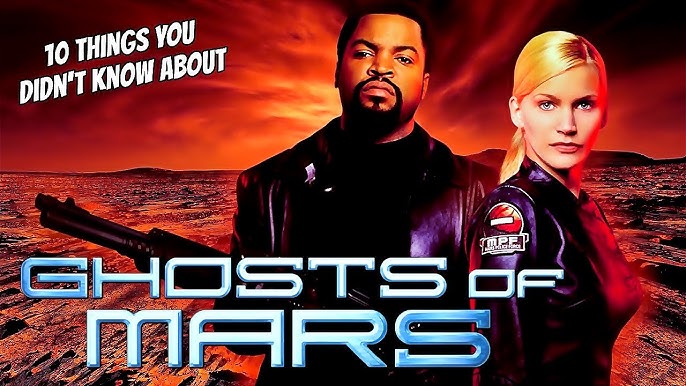Ghosts of Mars (2001)

“Ghosts of Mars,” released in 2001, is a unique blend of science fiction, horror, and Western genres directed by the legendary John Carpenter. Known for his distinctive style and contributions to the horror genre, Carpenter’s work in “Ghosts of Mars” showcases his signature flair for creating suspenseful and atmospheric films. With a cast that includes Natasha Henstridge, Ice Cube, and Jason Statham, the film presents a thrilling narrative set on a distant, desolate planet.
Set in the year 2176, “Ghosts of Mars” takes place on a mining colony located on the planet Mars. The film opens with a gripping prologue that establishes the tone and atmosphere, introducing viewers to a future where humanity has colonized other planets. However, the colony on Mars is far from a utopia; it is a harsh and unforgiving environment, filled with danger and uncertainty. As the plot unfolds, we learn that the miners have unwittingly disturbed an ancient Martian civilization, awakening malevolent spirits that possess the living and turn them into violent killers.
The narrative centers around a team of police officers, led by Lieutenant Melanie Ballard, played by Natasha Henstridge. Their mission is to transport a notorious criminal, Desolation Williams (Ice Cube), back to safety. However, their plans quickly unravel as they find themselves caught in a terrifying battle for survival against the possessed inhabitants of the colony. Carpenter masterfully combines action and horror elements, creating a relentless pace that keeps audiences on the edge of their seats.
One of the film’s standout aspects is its rich visual style. Carpenter’s direction shines through in the film’s cinematography, featuring expansive desert landscapes and claustrophobic interiors that heighten the sense of isolation. The use of vibrant colors, particularly the reds and oranges that evoke the Martian landscape, contributes to the film’s eerie atmosphere. The production design is equally impressive, successfully creating a gritty, industrial environment that serves as a backdrop for the chaos that unfolds.
 The concept of possession is central to the film, providing a unique twist on the typical horror narrative. The ancient Martian spirits, once awakened, take control of the living, transforming them into bloodthirsty apparitions. This theme of losing one’s agency resonates throughout the film, creating a palpable sense of dread as characters grapple with the knowledge that they are not in control of their fate. The haunting visuals of the possessed miners serve to enhance the horror elements, with their disheveled appearances and crazed expressions adding to the film’s tension.
The concept of possession is central to the film, providing a unique twist on the typical horror narrative. The ancient Martian spirits, once awakened, take control of the living, transforming them into bloodthirsty apparitions. This theme of losing one’s agency resonates throughout the film, creating a palpable sense of dread as characters grapple with the knowledge that they are not in control of their fate. The haunting visuals of the possessed miners serve to enhance the horror elements, with their disheveled appearances and crazed expressions adding to the film’s tension.
Character development is another key element of “Ghosts of Mars.” Natasha Henstridge’s portrayal of Lieutenant Ballard is particularly noteworthy, as she embodies a strong, determined female lead in a genre often dominated by male protagonists. Ballard’s journey from a no-nonsense police officer to a survivor fighting for her life against unimaginable horrors showcases her resilience and strength. Ice Cube’s character, Desolation Williams, adds a layer of complexity to the narrative. Initially introduced as a criminal, he ultimately becomes a reluctant ally in the fight against the supernatural forces, challenging the traditional notions of heroism and morality.

The film also explores themes of colonialism and the consequences of humanity’s actions. The miners’ greed and disregard for the ancient civilization on Mars serve as a cautionary tale about the dangers of exploitation. Carpenter weaves social commentary into the fabric of the narrative, prompting viewers to consider the implications of humanity’s relentless pursuit of resources and the potential consequences of disturbing forces beyond their understanding.

Despite receiving mixed reviews upon its release, “Ghosts of Mars” has since developed a cult following, celebrated for its unique blend of genres and Carpenter’s unmistakable style. Fans appreciate its campy charm, intense action sequences, and memorable one-liners. The film’s fusion of Western motifs, such as the lawmen versus outlaws dynamic, with science fiction elements creates a distinctive viewing experience that sets it apart from other films of the era.
The score, composed by Carpenter himself, further enhances the film’s atmosphere, featuring pulsating synths and haunting melodies that complement the on-screen action. The music contributes to the film’s tension, driving the narrative forward while heightening the emotional stakes for the characters.

In conclusion, “Ghosts of Mars” is a distinctive entry in John Carpenter’s filmography, blending science fiction, horror, and Western elements to create a thrilling narrative that explores themes of possession, survival, and the consequences of human actions. With strong performances from its cast, particularly Natasha Henstridge and Ice Cube, and Carpenter’s masterful direction, the film captivates audiences with its unique visual style and relentless pace. As it continues to gain recognition and appreciation among fans, “Ghosts of Mars” remains a testament to Carpenter’s enduring influence in the realms of horror and science fiction, solidifying its place as a cult classic in the genre.











